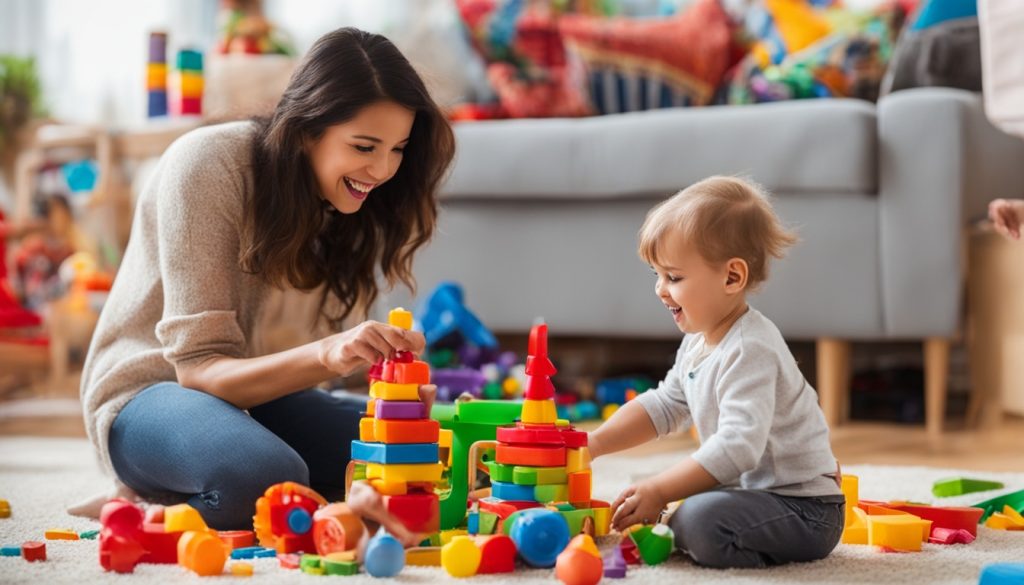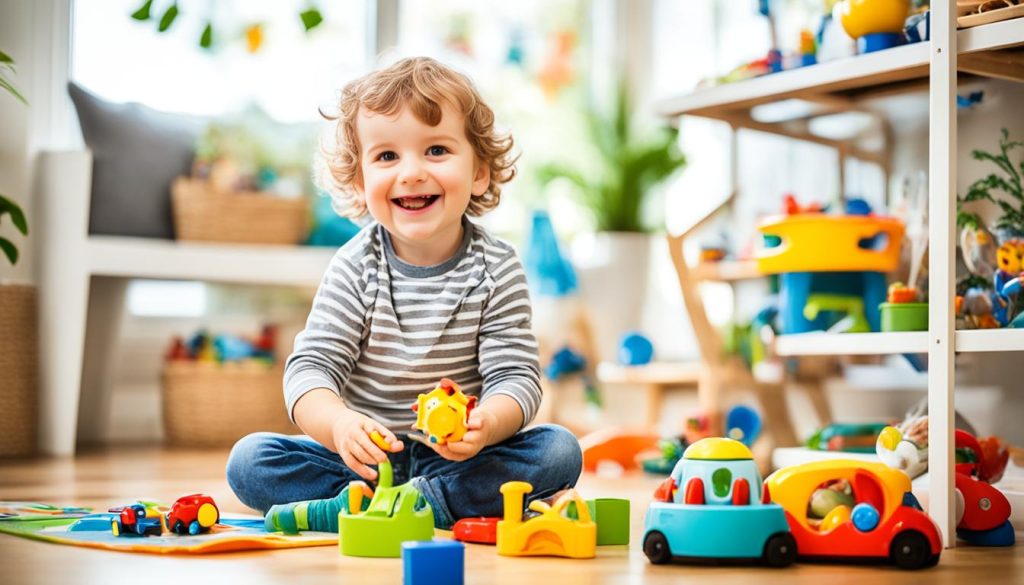The day I found myself on the kitchen floor, cradling my child through another meltdown, was a turning point. It showed me that managing child tantrums is more about understanding than control. If you’re reading this, you might have felt the overwhelming emotions that come with these outbursts. You’re not alone. Many parents face these intense moments, especially during child development milestones when kids learn to express independence.
Remember the last tantrum you saw? It might have been at bedtime, when tiredness and the end of a comforting routine caused it. Or it could have been during a transition, like from play to homework, when the change was too quick for your child. These meltdowns can leave you feeling drained and unsure of what to do next.
Child tantrums are common in kids from ages one to three. At this stage, they’re still learning how to control their feelings. It’s important to see these outbursts as a sign of a young brain struggling, not as “bad behavior.” While it might be tempting to quickly comfort or discipline your child, finding a balanced approach is key. This approach supports both understanding and independence.
We’ll look at ways to manage child tantrums that keep you sane and help your child learn better coping skills. With these insights and strategies, you’ll be better equipped to handle future meltdowns. This ensures a peaceful and supportive environment for your child’s growth.
Key Takeaways
- Tantrums in children aged 1-3 are common due to early stage social, emotional, and language development.
- Predictable situations, such as transitions or bedtime, often trigger meltdowns.
- Encouraging self-soothing techniques and structuring activities can help manage tantrums effectively.
- Ignoring non-dangerous outbursts and reinforcing positive behavior can reduce the frequency and intensity of tantrums over time.
- Parents should focus on proactive prevention by understanding triggers and modifying responses.
Understanding Tantrums and Their Triggers
Knowing why tantrums happen helps us deal with them better. It’s key to spot triggers like fear, frustration, and anger. These feelings can overwhelm kids, causing them to have meltdowns.

Fear, Frustration, and Anger
Children often feel fear in scary situations. Over 75% of kids with big temper tantrums might have ADHD. Anxiety can also make them react strongly, even if they don’t have a disorder. When kids can’t handle frustration or anger, they might throw tantrums a lot.
Research shows that kids who have a lot of tantrums might be sad or easily annoyed. Teaching them to understand and manage their feelings can make things easier for them.
Parents should watch for what sets off their child’s tantrums and change things if they can. Knowing how to help kids understand and express their feelings can cut down on tantrums. This can also stop extreme reactions like yelling or shutting down.
Sensory Overload
Sensory overload is a big reason for tantrums too. Too much stimulation can be too much for a child. This is especially true for kids on the autism spectrum or those with ADHD, who might have big meltdowns from sudden changes or too much going on.
Kids with sensory issues might react more strongly to certain sights, sounds, or smells. Managing screen time and other sensory inputs is key. By being aware of these triggers, parents can prepare for and handle situations that might lead to tantrums. Teaching kids how to deal with these challenges can help them a lot.
Understanding emotional and sensory triggers can really help in managing tantrums and helping kids grow emotionally. Spotting and dealing with these factors is crucial for building emotional smarts in kids. It also helps create a supportive place for them to grow.
Positive Parenting Techniques for Managing Tantrums
Positive reinforcement parenting is key in handling tantrums and creating a supportive space. It focuses on praising good actions and giving attention. This encourages your child to keep up the good behavior.

Offering children choices is a great way to manage tantrums. It gives them control and reduces fights. For example, letting them pick between a red or blue shirt helps prevent tantrums.
Dealing with sibling rivalry can be easier with positive parenting. Encouraging sharing and teamwork between siblings lowers fights. This approach not only helps now but also boosts their social skills later on.
Clear and consistent rules are vital in positive parenting. They make kids feel secure and less stressed, leading to fewer tantrums. Adding natural consequences teaches them responsibility and self-control.
- Distraction: Changing the focus to another activity stops a tantrum from getting worse.
- Setting Appropriate Expectations: Clear expectations help kids feel confident in different situations.
- Reinforcing Successful Behavior: Praising or rewarding good emotional management encourages more of it.
Teaching kids to be thankful is a big part of positive parenting. Activities like writing thank-you notes or talking about what they’re thankful for help them feel positive and smart about feelings.
The MIND, BODY AND SOUL TIME® method is all about spending 10-15 minutes a day with your child. This special time can change their behavior quickly. By focusing on positive interactions and solving sibling issues well, you help your child grow and develop.
| Strategy | Benefits |
|---|---|
| Offering Choices | Empowers children and reduces power struggles |
| Positive Reinforcement | Encourages repetition of good behavior |
| Consistent Expectations | Minimizes anxiety and fosters self-discipline |
| Mind, Body And Soul Time® | Promotes positive bonding and behavior improvement |
Assessing Child-Specific Tantrum Triggers
Understanding what makes your child throw tantrums is key to good parenting. By doing a child behavior assessment, you can find out what causes these outbursts. Knowing the patterns and acting on them can really help reduce how often and how bad tantrums happen.

Functional Assessment
Functional assessment means watching what happens right before, during, and after a tantrum. This helps you see what triggers the tantrums. For example, kids from 1 to 3 years old often have tantrums as they learn social and emotional skills.
Understanding this early on helps you teach your kids responsibility and handle their reactions better.
Identifying Patterns
Seeing patterns in your child’s behavior is key to handling tantrums. If you see that certain things, like switching from play to homework, often lead to tantrums, you can change how you handle it. Dr. Nicole Beurkens says kids from 3 to 4 have trouble controlling their emotions.
Parenting in the digital age offers many tools to help with this. It makes tracking and understanding triggers easier for parents.
When kids go from being only children to having siblings, it can change their behavior. They might feel jealous or want more attention. Things like diet, sleep, and health can also change how they act suddenly.
Staying calm, firm, and confident when checking out these patterns helps your child feel secure. Using specific methods for tantrums based on these patterns helps with parenting in the digital age. It cuts down on tantrums and helps your child become more resilient.
Preventing Tantrums Before They Start
Learning how to stop tantrums before they happen makes parenting easier. It starts with making sure your child gets enough sleep, eats well, and feels comfortable. These things are key to teaching kids good habits.
Helping your child become more independent is important. Letting them make choices within safe limits gives them control and confidence. This can lower their chance of getting upset.
Having a set playtime is also a good idea. Spending time outside is great for kids. It lets them release energy and feelings in a healthy way. This can stop tantrums before they start and helps kids grow strong and healthy.

- Daily Routines: A regular schedule makes kids feel secure and less anxious.
- Praise Good Behavior: Giving extra praise for good actions encourages more of it and cuts down on tantrums.
- Limited Timeouts: Timeouts should be used carefully to avoid making things worse.
- Emotion Validation: Accepting your child’s feelings helps prevent their emotions from getting out of control.
| Strategy | Benefits |
|---|---|
| Stable Routine | Makes things predictable and secure. |
| Positive Praise | Boosts confidence and encourages good behavior. |
| Outdoor Play | Helps with physical and emotional health. |
| Emotion Validation | Helps manage feelings during stressful times. |
Effective Discipline Strategies
Discipline is key to raising kind kids and teaching them right from wrong. It’s about guiding them, not just making them obey. By setting clear rules and sticking to them, kids learn what’s expected of them. The Canadian Paediatric Society says positive discipline is best and warns against spanking.
Adults with a close bond should discipline kids. For young toddlers, focus on safety and changing their focus. Older toddlers need limits set with care and to be redirected to other activities.
Ignoring the Tantrums
Ignoring tantrums doesn’t make them worse. Instead, focus on the good behavior. This teaches kids that being good gets attention. Doctors suggest guiding kids early to help parents manage tantrums.
Withdrawing Attention
Ignoring tantrums helps manage them without making them worse. By rewarding good behavior, kids learn what gets attention. This approach, along with clear rules, helps kids understand what’s expected. Teaching kids to behave well through positive actions and empathy is key.
“Effective discipline instills values, fosters acceptable behavior, and helps children learn self-discipline and a healthy internal sense of responsibility,” according to the American Academy of Pediatrics (AAP).
Teaching Emotional Intelligence in Children
Teaching emotional intelligence in children means helping them understand and express their feelings well. Emotional literacy is not always a focus in cultures, making it hard for kids to handle their emotions. By promoting emotional intelligence alongside intellectual growth, your child can really grow.
Parents are key in supporting their child’s mental health by talking about tough topics. This helps kids know their feelings, figure out why they feel them, and learn how to react. To coach emotions well, it’s important to follow certain steps, even though many parents don’t do this often. But, the good news is, kids who get this support do better in life, do well in school, and have better relationships.
Children start learning how to manage their feelings differently as they get older. By age four, they use simple ways to handle what’s happening around them. By age 10, they use more complex methods. A place like Woodline Primary School, which values emotional intelligence, growth mindset, and kindness, helps a lot with this.
“Creating a supportive atmosphere at home and discussing emotions openly can be a game-changer for your child’s emotional growth.”
Talking about emotional intelligence with your kids can also make your family closer and raise kids who are resilient and caring. Small, regular efforts to listen with kindness and talk about hard topics can lead to big, positive changes, as The Gottman Institute suggests.
| Benefits of Emotional Intelligence in Children | Outcomes |
|---|---|
| Improved Self-Control | Healthier lifestyle, more successful, less likely to have criminal records |
| Better Academic Performance | Higher grades, better school experience |
| Enhanced Relationships | Better friendships, stronger family connections |
Finally, focusing on emotional intelligence in kids helps them now and sets them up for success and happiness later on.
Building Self-Esteem in Children During Challenging Times
Building self-esteem in children during tough times is key for parents. When you show parenting with empathy and respect, you create a caring bond. This bond is crucial for a child’s self-esteem. Encouraging your child to try new things and praising their effort, not just their success, helps grow their creativity and self-worth.
Research shows that a child’s self-esteem is shaped by their surroundings and interactions. By age five, a child’s self-esteem is as strong as an adult’s. Kids with high self-esteem do better in life and bounce back from challenges. So, it’s important to use methods that help keep their confidence up.
Encouragement and Praise
Giving consistent encouragement and praise is key to building a child’s self-esteem. Praising specific actions or behaviors shows them what they’re doing right. Nurturing child creativity through activities that let them show off their skills also boosts their confidence.
Family activities that make children feel they belong also help their self-esteem. Positive messages from you can make them feel worthy and capable. Your guidance in how they act with friends and teachers is also crucial.
Positive Reinforcement
Positive reinforcement encourages good behavior and lifts self-esteem. Praising your child for their hard work and achievements motivates them to keep it up. Showing appreciation for who they are and what they do well is important.
Spend quality time with your child and truly value their efforts. This makes them feel important, which is key in hard times. But, too much praise can have negative effects, so be careful.
| Age Group | Influential Factors | Self-Esteem Strategy |
|---|---|---|
| Preschoolers | Comparison with peers | Encouragement for effort |
| School Age | Academic performance, physical appearance, social interactions | Specific praise, positive reinforcement |
| Early Adolescents | Peer relationships, independence challenges | Active listening, respectful feedback |
Developing Parent-Child Communication for Better Understanding
Building strong parent-child communication is key to a strong family bond. It means setting aside time to talk, like during meals, and turning off phones and TVs. This helps you and your child connect deeply, making them feel safe and secure.
Talking about daily life helps make conversations normal. This makes it easier to talk about big issues when they come up. Sharing a range of feelings helps your child learn to express themselves better. This creates a safe space for all emotions.
Listening well is vital in parent-child communication. Showing you’re interested through body language and eye contact helps you understand your child. It’s also important to let them finish speaking and use language they can understand.
Clear instructions and positive feedback help your child pay attention and communicate better. Feeling loved and accepted makes them more open to sharing their thoughts and feelings. This leads to a happier family life and better balancing work and family through cooperation and understanding.
Here are some tips for better parent-child talks:
- Talk briefly when your child is young to keep their attention.
- Show you accept them in words and actions.
- Talk at their level to make them feel more comfortable.
- Use open-ended questions to get them to share more.
- Pay full attention when they want to talk to you.
Using these tips can improve parent-child communication. It builds a strong base of family respect and empathy. This helps your family deal with challenges and creates a supportive environment for work and family life.
| Strategy | Benefit | Action |
|---|---|---|
| Dedicated Conversation Time | Enhanced Bonding | Set specific times for family conversations. |
| Remove Distractions | Increased Focus | Turn off phones and TVs during talks. |
| Discuss Emotions | Emotional Vocabulary | Encourage conversations about feelings. |
| Active Listening | Stronger Relationships | Use eye contact and respond with interest. |
| Clear Instructions | Better Attention | Provide simple, clear guidance with praise. |
Parenting and Raising Kids: A Guide to Tantrum Management
Managing tantrums is key in parenting. It’s important to be consistent and set clear rules. This helps create a stable world for kids, making it easier for them to know what’s expected.
Young kids find sudden changes hard and may throw tantrums. Being consistent helps avoid these meltdowns.
Consistency is Key
It’s crucial to always react the same way to your child’s actions. Kids from 3 to 5 love routine and predictability. Without it, they might get upset easily.
Being consistent teaches them what’s okay and what’s not. It also means praising good behavior and handling tantrums calmly. This positive approach builds a caring and stable home, showing your child what’s expected.
Setting Clear Boundaries
Setting clear limits helps kids understand their world better. For kids aged 6 to 7, it’s important as they learn about fairness, which lowers tantrums. As they get older, from 8 to 10, they notice more when things aren’t fair.
It’s key to explain these limits clearly to make them feel safe and valued.
Helping kids grow emotionally and behaviorally takes patience and understanding. Managing tantrums means more than just dealing with the tantrums. It’s about teaching them for life. By teaching emotional smarts and clear rules, you help them do well emotionally and behaviorally.
FAQ
What are some effective ways to manage child tantrums?
Why do children have tantrums?
What is a functional assessment, and how does it help manage tantrums?
How can I prevent tantrums before they start?
What role does emotional intelligence play in managing tantrums?
How can positive parenting techniques help in managing tantrums?
What’s the importance of building self-esteem in children during challenging times?
How can I develop better parent-child communication to prevent tantrums?
Why is consistency important in managing child tantrums?
This post contains affiliate links. If you click on a link and make a purchase, I may earn a small commission — at no extra cost to you. Thank you for supporting this blog and helping me keep the patterns free! Read the full Affiliate Disclosure & Transparency.
